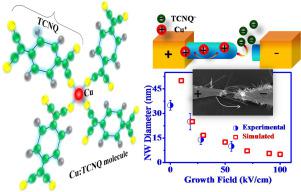Nano-Structures & Nano-Objects Pub Date : 2021-02-18 , DOI: 10.1016/j.nanoso.2021.100689 Rabaya Basori

|
Ultrathin Cu:TCNQ (Cu-tetracyanoquinodimethane) nanowires (10–50 nm diameter) are interesting from a fundamental point of view to study electrical as well as opto-electronic transport and also held promising interest in nanoelectronics, particularly for photodetector applications. Dielectrophoresis-based device fabrication from an aqueous solution is useful and has some potential applications. However, such device fabrication may degrade material property. Herein, we demonstrate directed in-situ growth and assembly of Cu:TCNQ nanowire at predefined electrodes in vacuum using dc dielectrophoresis. The mechanistic understanding of the process is verified by COMSOL Multiphysics simulation. The externally applied electric field also exploits to control over the number as well as diameter of the nanowire during growth. Field grown nanowires bridging two electrodes are structurally characterized using a unique challenging technique with Transmission Electron Microscope. The field-grown nanowires are found to have better electrical performance compared to normal growth.
中文翻译:

利用介电泳力原位生长和控制直径的金属有机电荷转移复合纳米线器件
超薄Cu:TCNQ(Cu-四氰基喹二甲烷)纳米线(从基本的角度来看,研究电学和光电学传输非常有趣(直径10–50 nm),并且对纳米电子学,尤其是光电探测器应用,也抱有广阔的兴趣。由水溶液制备基于介电电泳的器件是有用的,并且具有一些潜在的应用。但是,这样的器件制造会降低材料性能。在这里,我们演示了使用直流介电法在真空中的预定电极上定向生长和组装Cu:TCNQ纳米线。通过COMSOL Multiphysics仿真验证了对过程的机械理解。外部施加的电场还用于控制生长过程中纳米线的数量和直径。使用独特的具有挑战性的透射电子显微镜技术,可以对桥接两个电极的场生长纳米线进行结构表征。发现与正常生长相比,现场生长的纳米线具有更好的电性能。











































 京公网安备 11010802027423号
京公网安备 11010802027423号